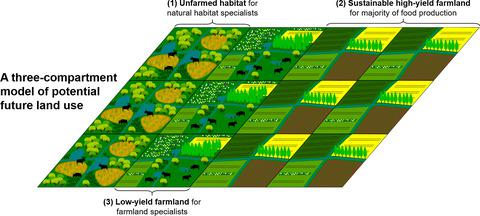当前位置:
X-MOL 学术
›
J. Appl. Ecol.
›
论文详情
Our official English website, www.x-mol.net, welcomes your
feedback! (Note: you will need to create a separate account there.)
Optimising nature conservation outcomes for a given region‐wide level of food production
Journal of Applied Ecology ( IF 5.0 ) Pub Date : 2020-03-22 , DOI: 10.1111/1365-2664.13594 Tom Finch 1 , Rhys E. Green 2 , Dario Massimino 3 , Will J. Peach 1 , Andrew Balmford 2
中文翻译:

针对特定区域范围的粮食生产水平优化自然保护成果
更新日期:2020-03-22
Journal of Applied Ecology ( IF 5.0 ) Pub Date : 2020-03-22 , DOI: 10.1111/1365-2664.13594 Tom Finch 1 , Rhys E. Green 2 , Dario Massimino 3 , Will J. Peach 1 , Andrew Balmford 2
Affiliation

|
- The land sharing‐sparing framework aims to quantify the trade‐off between food production and biodiversity conservation, but it has been criticized for offering, for reasons of simplicity, an unrealistically limited set of different land uses.
- Here, we develop the framework to evaluate a much larger suite of land‐use strategies in which the areas and yields of three land‐use compartments - natural habitat, high‐yield farmland, and lower‐yield farmland - are varied simultaneously. For two regions of England, we use functions that relate the local population density of breeding bird species to farm yield to simulate species‐specific region‐wide population sizes under each strategy.
- We find that geometric mean population size, averaged across all species, is maximized when farmland yields are higher than the current average yield, and when spared land combines both natural habitat and low‐yield farmland. This conclusion is relatively insensitive to the maximum yield considered feasible under extreme land sparing, and holds across a range of region‐wide food production targets.
- To some extent, our conclusion depends on which species groups were included in the assessment. Considered alone, farmland birds preferred a strategy with little or no natural habitat. Nonetheless, the optimal strategy was broadly consistent across all widely recognized listings of species of conservation concern.
- Synthesis and applications. Our study looks at landscapes with a long history of agricultural use, and which have little remaining natural habitat, such as those found in lowland England. In these landscapes, conservation outcomes are likely to be maximized by mixed strategies in which high‐yield production enables an increase in area of both natural habitat and low‐yield farmland elsewhere in the region.
中文翻译:

针对特定区域范围的粮食生产水平优化自然保护成果
- 土地共享保护框架旨在量化粮食生产与生物多样性保护之间的权衡取舍,但是由于简单起见,有人批评它提供了一组不切实际的有限的不同土地用途。
- 在这里,我们开发了一个框架,以评估一套更大的土地利用策略,其中三个土地利用分区(自然栖息地,高产农田和低产农田)的面积和产量同时变化。对于英格兰的两个地区,我们使用将育种鸟的当地种群密度与农场产量相关联的函数,以模拟每种策略下特定于物种的整个地区的种群规模。
- 我们发现,当农田的产量高于当前的平均产量,并且闲置的土地将自然栖息地和低产农田结合在一起时,所有物种的平均几何平均种群规模将最大化。该结论对在极端土地保留下认为可行的最大单产相对不敏感,并且适用于整个区域范围的粮食生产目标。
- 在某种程度上,我们的结论取决于评估中包括哪些物种组。单独考虑,农田鸟类更喜欢很少或没有自然栖息地的策略。尽管如此,在所有有关保护的物种中,最佳策略在所有公认的物种中都基本一致。
- 综合与应用。我们的研究着眼于具有悠久农业使用历史且几乎没有自然栖息地的景观,例如在英格兰低地发现的景观。在这些景观中,通过混合策略可以最大程度地提高保护效果,在这种策略中,高产可增加该地区其他地方的自然栖息地和低产农田的面积。










































 京公网安备 11010802027423号
京公网安备 11010802027423号